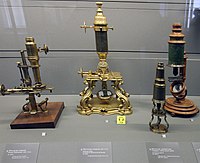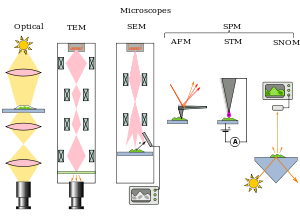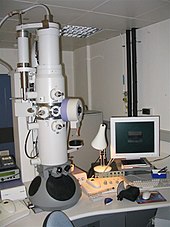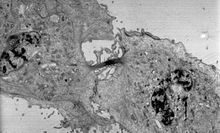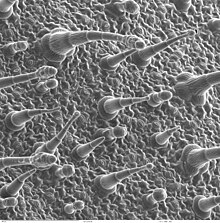PHYSICS PROJECT REPORT ON MICROSCOPE
A microscope (from the Ancient Greek: μικρός, mikrós, “small” and σκοπεῖν, skopeîn, “to look” or “see”) is an instrument used to see objects that are too small to be seen by the naked eye. Microscopy is the science of investigating small objects and structures using such an instrument. Microscopic means invisible to the eye unless aided by a microscope.
There are many types of microscopes, and they may be grouped in different ways. One way is to describe the way the instruments interact with a sample to create images, either by sending a beam of light or electrons to a sample in its optical path, or by scanning across, and a short distance from, the surface of a sample using a probe. The most common microscope (and the first to be invented) is the optical microscope, which uses light to pass through a sample to produce an image. Other major types of microscopes are the fluorescence microscope, the electron microscope (both, the transmission electron microscope and the scanning electron microscope) and the various types of scanning probe microscopes.
Contents
History
18th-century microscopes from the Musée des Arts et Métiers, Paris
Although objects resembling lenses date back 4000 years and there are Greek accounts of the optical properties of water-filled spheres (5th century BC) followed by many centuries of writings on optics, the earliest known use of simple microscopes (magnifying glasses) dates back to the widespread use of lenses in eyeglasses in the 13th century.The earliest known examples of compound microscopes, which combine an objective lens near the specimen with an eyepiece to view a real image, appeared in Europe around 1620.The inventor is unknown although many claims have been made over the years. Several revolve around the spectacle-making centers in the Netherlands including claims it was invented in 1590 by Zacharias Janssen (claim made by his son) and/or Zacharias’ father, Hans Martensclaims it was invented by their neighbor and rival spectacle maker, Hans Lippershey (who applied for the first telescope patent in 1608)and claims it was invented by expatriate Cornelis Drebbel who was noted to have a version in London in 1619. Galileo Galilei (also sometimes cited as compound microscope inventor) seems to have found after 1610 that he could close focus his telescope to view small objects and, after seeing a compound microscope built by Drebbel exhibited in Rome in 1624, built his own improved versionGiovanni Faber coined the name microscope for the compound microscope Galileo submitted to the Accademia dei Lincei in 1625[14] (Galileo had called it the “occhiolino” or “little eye“).
Rise of modern light microscopes
The first detailed account of the microscopic anatomy of organic tissue based on the use of a microscope did not appear until 1644, in Giambattista Odierna’s L’occhio della mosca, or The Fly’s Eye.
The microscope was still largely a novelty until the 1660s and 1670s when naturalists in Italy, the Netherlands and England began using them to study biology, both organisms and their ultrastructure. Italian scientist Marcello Malpighi, called the father of histology by some historians of biology, began his analysis of biological structures with the lungs. Robert Hooke‘s Micrographia had a huge impact, largely because of its impressive illustrations. A significant contribution came from Antonie van Leeuwenhoek who achieved up to 300 times magnification using a simple single lens microscope. He sandwiched a very small glass ball lens between the holes in two metal plates riveted together, and with an adjustable-by-screws needle attached to mount the specimen.Then, Van Leeuwenhoek re-discovered red blood cells (after Jan Swammerdam) and spermatozoa, and helped popularise the use of microscopes to view biological ultrastructure. On 9 October 1676, van Leeuwenhoek reported the discovery of micro-organisms.
The performance of a light microscope depends on the quality and correct use of the condensor lens system to focus light on the specimen and the objective lens to capture the light from the specimen and form an image.Early instruments were limited until this principle was fully appreciated and developed from the late 19th to very early 20th century, and until electric lamps were available as light sources. In 1893 August Köhler developed a key principle of sample illumination, Köhler illumination, which is central to achieving the theoretical limits of resolution for the light microscope. This method of sample illumination produces even lighting and overcomes the limited contrast and resolution imposed by early techniques of sample illumination. Further developments in sample illumination came from the discovery of phase contrast by Frits Zernike in 1953, and differential interference contrast illumination by Georges Nomarski in 1955; both of which allow imaging of unstained, transparent samples.
Electron microscopes
Electron microscope constructed by Ernst Ruska in 1933
In the early 20th century a significant alternative to the light microscope was developed, an instrument that uses a beam of electrons rather than light to generate an image. The German physicist, Ernst Ruska, working with electrical engineer Max Knoll, developed the first prototype electron microscope in 1931, a transmission electron microscope (TEM). The transmission electron microscope works on similar principles to an optical microscope but uses electrons in the place of light and electromagnets in the place of glass lenses. Use of electrons, instead of light, allows for much higher resolution.
Development of the transmission electron microscope was quickly followed in 1935 by the development of the scanning electron microscopeby Max Knoll. Although TEMs were being used for research before WWII, and became popular afterwards, the SEM was not commercially available until 1965.
Transmission electron microscopes became popular following the Second World War. Ernst Ruska, working at Siemens, developed the first commercial transmission electron microscope and, in the 1950s, major scientific conferences on electron microscopy started being held. In 1965, the first commercial scanning electron microscope was developed by Professor Sir Charles Oatley and his postgraduate student Gary Stewart, and marketed by the Cambridge Instrument Company as the “Stereoscan”.
One of the latest discoveries made about using an electron microscope, is the ability to identify a virus.Since this microscope reflects a visible, clear image of small organelles, then in an electron microscope there will no need for reagents to see the virus or harmful cells, resulting with more efficient way for pathogen detection.
Scanning probe microscopes
From 1981 to 1983 Gerd Binnig and Heinrich Rohrer worked at IBM in Zurich, Switzerland to study the quantum tunnelling phenomenon and eventually create a practical instrument, a scanning probe microscope from quantum tunnelling theory that read very small forces exchanged between a probe and the surface of a sample. The probe almost meets the surface so closely that the electrons for an experiment are able to have a continuous flow of electrons, making a current from surface to the probe. The microscope was not initially well received due to the complex nature of the underlying theoretical explanations. In 1984 Jerry Tersoffand D.R. Hamann while at AT&T’s Bell Laboratories in Murray Hill, New Jersey began publishing articles that tied the theoretical with the experimental results obtained by the instrument. This was closely followed in 1985 with functioning commercial instruments, and in 1986 with Gerd Binnig, Quate, and Gerber’s invention of the atomic force microscope, then Binnig’s and Rohrer’s Nobel Prize in Physics for the SPM.
Scanning probe microscope types have continued to be developed as the ability to machine ultra fine probes and tips has advanced.
Fluorescence microscopes
The most recent developments in light microscope largely centre on the rise of fluorescence microscopy in biology. During the last decades of the 20th century, particularly in the post-genomic era, many techniques for fluorescent staining of cellular structures were developed.The main groups of techniques involve targeted chemical staining of particular cell structures, for example, the chemical compound DAPI to label DNA, use of antibodies conjugated to fluorescent reporters, see immunofluorescence, and fluorescent proteins, such as green fluorescent proteinThese techniques use these different fluorophores for analysis of cell structure at a molecular level in both live and fixed samples.
The rise of fluorescence microscopy drove the development of a major modern microscope design, the confocal microscope. The principle was patented in 1957 by Marvin Minsky, although laser technology limited practical application of the technique. It was not until 1978 when Thomas and Christoph Cremer developed the first practical confocal laser scanning microscope and the technique rapidly gained popularity through the 1980s.
Super resolution microscopes
Much current research (in the early 21st century) on optical microscope techniques is focused on development of superresolution analysis of fluorescently labelled samples. Structured illumination can improve resolution by around two to four times and techniques like stimulated emission depletion (STED) microscopy are approaching the resolution of electron microscopes. This occurs because the diffraction limit is occurred from light or excitation, which makes the resolution must be doubled to become super saturated. Stefan Hell was awarded the 2014 Nobel Prize in Chemistry for the development of the STED technique, along with Eric Betzig and William Moerner who adapted fluorescnence microscopy for single-molecule viusalization.
X-ray microscopes
X-ray microscopes are instruments that use electromagnetic radiation usually in the soft X-ray band to image objects. Technological advances in x-ray lens optics in the early 1970s made the instrument a viable imaging choice. They are often used in tomography (see micro-computed tomography) to produce three dimensional images of objects, including biological materials that have not been chemically fixed. Currently research is being done to improve optics for hard x-rays which have greater penetrating power.
Types
Microscopes can be separated into several different classes. One grouping is based on what interacts with the sample to generate the image, i.e., light or photons (optical microscopes), electrons (electron microscopes) or a probe (scanning probe microscopes). Alternatively, microscopes can be classed on whether they analyze the sample via a scanning point (confocal optical microscopes, scanning electron microscopes and scanning probe microscopes) or analyze the sample all at once (wide field optical microscope and transmission electron microscopes).
Wide field optical microscopes and transmission electron microscopes both use the theory of lenses (optics for light microscopes and electromagnet lenses for electron microscopes) in order to magnify the image generated by the passage of a wave transmitted through the sample, or reflected by the sample. The waves used are electromagnetic (in optical microscopes) or electron beams (in electron microscopes). Resolution in these microscopes is limited by the wavelength of the radiation used to image the sample, where shorter wavelengths allow for a higher resolution.
Scanning optical and electron microscopes, like the confocal microscope and scanning electron microscope, use lenses to focus a spot of light or electrons onto the sample then analyze the signals generated by the beam interacting with the sample. The point is then scanned over the sample to analyze a rectangular region. Magnification of the image is achieved by displaying the data from scanning a physically small sample area on a relatively large screen. These microscopes have the same resolution limit as wide field optical, probe, and electron microscopes.
Scanning probe microscopes also analyze a single point in the sample and then scan the probe over a rectangular sample region to build up an image. As these microscopes do not use electromagnetic or electron radiation for imaging they are not subject to the same resolution limit as the optical and electron microscopes described above.
Optical
The most common type of microscope (and the first invented) is the optical microscope. This is an optical instrument containing one or more lenses producing an enlarged image of a sample placed in the focal plane. Optical microscopes have refractiveglass and occasionally of plastic or quartz, to focus light into the eye or another light detector. Mirror-based optical microscopes operate in the same manner. Typical magnification of a light microscope, assuming visible range light, is up to 1250x with a theoretical resolution limit of around 0.250 micrometres or 250 nanometres.This limits the practical magnification limit to ~1500x. Specialized techniques (e.g., scanning confocal microscopy, Vertico SMI) may exceed this magnification but the resolution is diffraction limited. The use of shorter wavelengths of light, such as the ultraviolet, is one way to improve the spatial resolution of the optical microscope, as are devices such as the near-field scanning optical microscope.
Sarfus, a recent optical technique increases the sensitivity of standard optical microscope to a point it becomes possible to directly visualize nanometric films (down to 0.3 nanometre) and isolated nano-objects (down to 2 nm-diameter). The technique is based on the use of non-reflecting substrates for cross-polarized reflected light microscopy.
Ultraviolet light enables the resolution of microscopic features, as well as to image samples that are transparent to the eye. Near infrared light can be used to visualize circuitry embedded in bonded silicon devices, since silicon is transparent in this region of wavelengths.
In fluorescence microscopy, many wavelengths of light, ranging from the ultraviolet to the visible can be used to cause samples to fluoresce to allow viewing by eye or with the use of specifically sensitive cameras.
Phase contrast microscopy is an optical microscopy illumination technique in which small phase shifts in the light passing through a transparent specimen are converted into amplitude or contrast changes in the image The use of phase contrast does not require stainingto view the slide. This microscope technique made it possible to study the cell cycle in live cells.
The traditional optical microscope has more recently evolved into the digital microscope. In addition to, or instead of, directly viewing the object through the eyepieces, a type of sensor similar to those used in a digital camera is used to obtain an image, which is then displayed on a computer monitor. These sensors may use CMOS or charge-coupled device (CCD) technology, depending on the application.
Digital microscopy with very low light levels to avoid damage to vulnerable biological samples is available using sensitive photon-countingdigital cameras. It has been demonstrated that a light source providing pairs of entangled photons may minimize the risk of damage to the most light-sensitive samples. In this application of ghost imaging to photon-sparse microscopy, the sample is illuminated with infrared photons, each of which is spatially correlated with an entangled partner in the visible band for efficient imaging by a photon-counting camera
Electron
The two major types of electron microscopes are transmission electron microscopes (TEMs) and scanning electron microscopes (SEMs). They both have series of electromagnetic and electrostatic lenses to focus a high energy beam of electrons on a sample. In a TEM the electrons pass through the sample, analogous to basic optical microscopy.[20] This requires careful sample preparation, since electrons are scattered strongly by most materials The samples must also be very thin (50-100 nm) in order for the electrons to pass through it.Cross-sections of cells stained with osmium and heavy metals reveal clear organelle membranes and proteins such as ribosomes. With a 0.1 nm level of resolution, detailed views of viruses (20-300 nm) and a strand of DNA (2 nm in width) can be obtained.In contrast, the SEM has raster coils to scan the surface of bulk objects with a fine electron beam. Therefore, the specimen do not necessarily need to be sectioned, but require coating with a substance such as a heavy metal. This allows three-dimensional views of the surface of samples.
Scanning probe
The different types of scanning probe microscopes arise from the many different types of interactions that occur when a small probe of some type is scanned over and interacts with a specimen. These interactions or modes can be recorded or mapped as function of location on the surface to form a characterization map. The three most common types of scanning probe microscopes are atomic force microscopes (AFM), near-field scanning optical microscopes (MSOM or SNOM, scanning near-field optical microscopy), and scanning tunneling microscopes(STM).An atomic force microscope has a fine probe, usually of silicon or silicon nitride, attached to a cantilever; the probe is scanned over the surface of the sample, and the forces that cause an interaction between the probe and the surface of the sample are measured and mapped. A near-field scanning optical microscope is similar to an AFM but its probe consists of a light source in an optical fiber covered with a tip that has usually an aperture for the light to pass through. The microscope can capture either transmitted or reflected light to measure very localized optical properties of the surface, commonly of a biological specimen. Scanning tunneling microscopes have a metal tip with a single apical atom; the tip is attached to a tube through which a current flows.The tip is scanned over the surface of a conductive sample until a tunneling current flows; the current is kept constant by computer movement of the tip and an image is formed by the recorded movements of the tip.
Other types
Scanning acoustic microscopes use sound waves to measure variations in acoustic impedance. Similar to Sonar in principle, they are used for such jobs as detecting defects in the subsurfaces of materials including those found in integrated circuits. On February 4, 2013, Australian engineers built a “quantum microscope” which provides unparalleled precision.
LOOKING FOR A WORKING MODEL FOR SCHOOL OR COLLEGE?
12th class is a no risk class. It is the class which decide your future. Whether you are going to work in MNC or going to work with usual private firms, it all depends here. To ensure the good marks to students we always stands behind them with all practical and theoretical support on Physics investigatory project. These Physics investigatory projects are usually have to be made by all students with physics and to be shown in boards practical. We at Gurukul Technicals Institute provide every student the theory behind the projects and give all possible required material to make the project work successfully. We duly provide equipped lab with latest lab materials. Conductors and Semiconductors are provided with Circuit diagram so that student can make project easily. Students make projects such as Full wave rectifier, Half wave rectifier, Fire alarm, rain alarm, Electromagnetic Induction, Logic gates(AND gate, OR gate, NOT gate, XAND gate, XNOR gate), Transistor as switch, Transistor as amplifier, Charging and Discharging of Capacitors, Series and Parallel Resistance etc etc. Students also get help on making these above given projects to made on cardboard or on breadboard as instructed by teacher. Students are also welcome to take help on report on given physics investigatory projects. After reading this website you can also send this information to your friend or relative studying in 12th class so it will make useful to him/her.
Get Readymade Project anywhere in India on just a Click away! That too with Report!
Prompt Delivery! COD Available! All over India Delivery! Order Now!!
CLICK HERE TO VIEW ALL 12th CLASS INVESTIGATORY PROJECT WITH REPORT LISTED ON AMAZON.IN WEBSITE
CLICK HERE TO VIEW MINOR,MAJOR AND ALL OTHER INVESTIGATORY PROJECTS ON FLIPKART.COM WEBSITE
Physics Projects with Reports:
- TO CONSTRUCT A CIRCUIT FOR TOUCH ALARM.
- EDDY CURRENT {WITHOUT MODEL }
- PHOTOCONDUCTIVE CELL
- MUTUAL INDUCTION
- TO STUDY NPN-TRANSISTOR AMPLIFIER
- TO CONSTRUCT A ELECTRIC MOTORS (D.C.MOTOR)
- TO STUDY HOW A TRANSISTOR AMPLIFIER WORK ‘PNP’ AMPLIFIER TRANSISTOR.
- HOUSEHOLD CIRCUITS
- AC TO DC CONVERTER (FULL WAVE RECTIFIER)
- AC TO DC CONVERTER (HALF WAVE RECTIFIER)
- TO CONSTRUCT A CIRCUIT OF FENCE WIRE BURGLAR ALARM
- TO SHOW THE PRINCIPLE OF FARADAY’S AND A.C. GENERATOR.
- THERMOCOUPLE
- TO STUDY FARADAY’S LAWS-TO FIND THE CHARGE ON AN ELECTRON
- FARADAY’S LAW’S OF ELECTROLYSIS
- TO STUDY A POSITIVE FEED BACK CIRCUIT OF AN AUDIO OSCILLATOR (LC OSCILLATOR)
- HOW DOES AN ELECTRIC GENERATOR WORK
- TO SHOW THAT A SOLENOID CARRYING AN ELECTRIC CURRENT PRODUCES A MAGNETIC FIELD SIMILAR TO THAT PRODUCED BY A BAR MAGNET.
- ELECTROCHEMICAL CELL (PRIMARY CELL)
- BOOLAN LOGIC GATE
- TO STUDY THE CHARGE AND DISCHARGING OF CAPACITOR IN SERIES
- WORKING OF POTENTIOMETER
- KIRCHOFF’S LAW
- TO DEMONSTRATE THE WORKING OF AN ELECTROLYTIC CAPACITOR BY MEANS OF ITS CHARGING AND DISCHARGING WITH THE HELP OF AN AUDIO OSCILLATOR AND TO STUDY AND COMPARE THE TWO CAPACITORS UNDER SERIES AND PARALLEL COMBINATION.(Z)
- RADIOACTIVITY AND NUCLEAR REACTIONS.
- RADIOISOTOPE THERMOELECTRIC GENERATOR.
- TO CONSTRUCT A CIRCUIT OF SOUND OPERATED SWITCH.
- TO CONSTRUCT A CIRCUIT OF TIME OPERATED SWITCH.
- TO CONSTRUCT A CIRCUIT OF SOUND AMPLIFIER.
- TO CONSTRUCT A CIRCUIT OF A FIRE ALARM.
- TO CONSTRUCT A CIRCUIT OF CLAP SWITCH.
- TO CONSTRUCT A CIRCUIT OF TRANSISTOR SWITCH
- TO FIND OUT OPTICAL ACTIVITY ARISES WHEN THE POLARIZATION AXIS OF LIGHT IS ROTATED AS IT PASSES THROUGH A SUBSTANCE
- PUSH-PULL AMPLIFIER
- HARTLEY OSCILLATORS
- PUSH PULL AMPLIFIER
- REPORT ON MAGNETIC FIELDS, MAGNETIC FORCES, AND ELECTROMAGNETIC INDUCTION LAWS OF REFRACTION (Z).
- RAY OPTICS-TO FIND REFRACTIVE INDEX OF THE MATERIAL OF THE PRISM BY TOTAL INTERNAL REFRACTION (Z).
- TO DEMONSTRATE THE WORKING OF AN ELECTROLYTIC CAPACITOR BY MEANS OF ITS CHARGING AND DISCHARGING WITH THE HELP OF AN AUDIO OSCILLATOR AND TO STUDY AND COMPARE THE TWO CAPACITORS UNDER SERIES AND PARALLEL COMBINATIONS.
- TO STUDY THE EFFECT OF THE DIAMETER AND THE NUMBER OF TURNS OF THE SPRING ON ITS STRENGTH HAS BEEN INVESTIGATION IN THIS STUDY.(Z)
- TO FIND OUT THE THERMAL COEFFICIENT OF RESISTANCE FOR A DIVAN SET OF WIRES AND THUS SUGGEST THE WIRE IN WHICH ENERGY LOSS DUE TO HEAT GENERATION IS MINIMUN.(Z)
- TO SEE THAT WATER CONDUCTS ELECTRICITY BETTER WHEN IMPURITIES ARE ADDED IT. (Z)
- TO MAKE NOR GATE WITH THE COMBINATION OF TWO GATES. (Z)
- PASCAL’S LAW AND ITS APPLICATIONS
- BRIDGE RECTIFIER- A CIRCUIT USING FOUR DIODES TO PROVIDE FULL WAVE RECTIFICATION.CONVERTS AN AC VOLTAGE TO A PULSATING DC VOLTAGE.
- TO CONSTRUCT A CIRCUIT OF QUIZ BUZZER.
- TO CONSTRUCT A CIRCUIT OF LASER SECURITY SYSTEM.
- TO CONSTRUCT A CIRCUIT OF RAIN ALARM.
- TO CONSTRUCT A CIRCUIT OF WATER LEVEL INDICATOR.
- THE EFFECT OF TEMPERATURE ON DISPOSABLE AND NON DISPOSABLE BATTERIES
- TO INVESTIGATE THE EFFECT OF THE FOLLOWING FACTORS ON THE INTERNAL RESISTANCE OF A LACLANCHE CELL.
- TO CONSTRUCT A CIRCUIT OF OPTICAL SWITCHING.
- TO CONSTRUCT A CIRCUIT OFCAPACITOR CHARGE OSCILATOR
- TO CONSTRUCT A CIRCUIT OFCAPACITOR STORAGE LED
- TO CONSTRUCT A CIRCUIT OF TWO TRANSISTOR OSCILLATOR
- EXPERIMENTS IN ELECTROCHEMISTRY
- TO SHOW THE UNIDIRECTION ACTION OF DIODE
- OPTICAL FIBER COMMUNICATION
- TO CONSTRUCT A CIRCUIT OF ELECTRONIC EYE
NOT IN THE LIST? WHATSAPP ON 9711699511 SO WE CAN SPECIALLY MADE IT FOR YOU. EITHER ON MULTIPURPOSE PCB OR BREAD BOARD.
